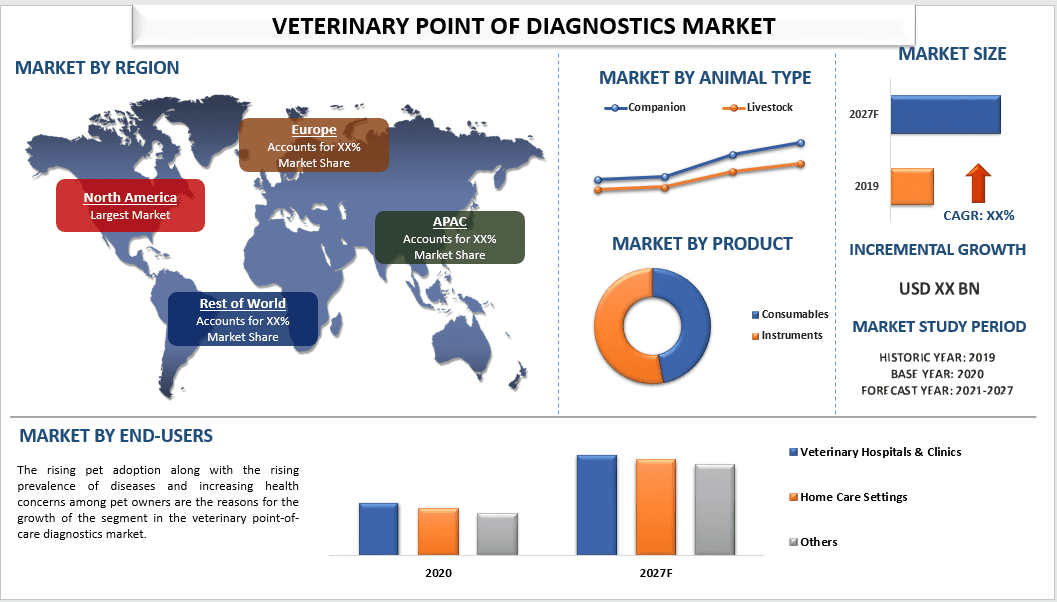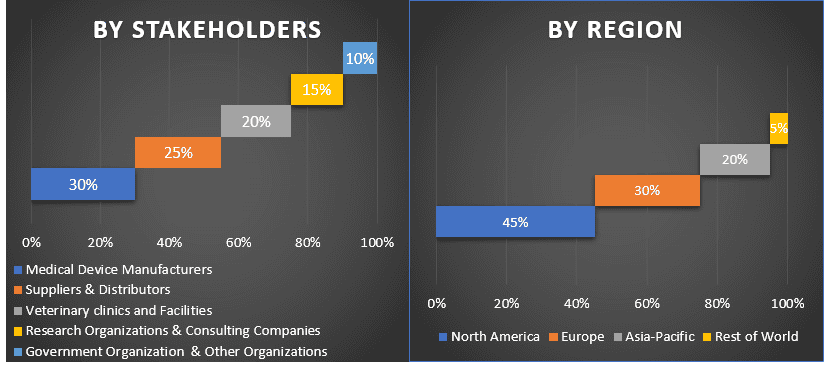Рынок ветеринарной диагностики в месте оказания помощи: текущий анализ и прогноз (2021-2027 гг.)
Акцент на типе животных (сельскохозяйственные и домашние); продукте (расходные материалы и инструменты); конечных пользователях (ветеринарные больницы и клиники, домашний уход и другие); регионе/стране

ЗАПРОСИТЬ БЕСПЛАТНЫЙ ОБРАЗЕЦ PDF
Диагностика на месте оказания медицинской помощи (POCD) играет ключевую роль в секторе здравоохранения. Со временем она привлекла значительное внимание благодаря быстрой диагностике различных опасных для жизни или инфекционных заболеваний, таких как рак, диабет и инфекционные заболевания, а также для мониторинга состояния здоровья пациентов. POC-устройства рассматриваются как эффективные варианты диагностики для предотвращения задержек в лечении, что является важным аспектом в предотвращении высокой смертности и передачи инфекционных агентов.
Ожидается, что мировой рынок ветеринарной диагностики на месте оказания медицинской помощи будет расти со значительным среднегодовым темпом роста (CAGR) около 12% в течение прогнозируемого периода (2021-2027 гг.). Растущие усилия по сохранению животных являются одной из основных причин использования современных технологий для выявления заболеваний у животных, что значительно увеличивает размер рынка POCD в ветеринарном лечении. Кроме того, ускорение программ разведения исчезающих видов, вероятно, окажет положительное влияние на рынок. Например, калифорнийский кондор когда-то находился на грани исчезновения — их осталось всего 27 особей. Птиц забрали в неволю, чтобы начать программу разведения, чтобы спасти калифорнийского кондора от вымирания. Кроме того, растущее число заболеваний среди домашнего скота и домашних животных является важным фактором значительного роста рынка ветеринарных эндоскопов.
IDEXX Laboratories, Zoetis, Virbac, Heska Corporation, Thermo Fisher Scientific, Inc., Neogen Corporation, Mindray, Esaote SpA, FUJIFILM Corporation и Woodley Equipment Company Ltd. Этими игроками было предпринято несколько слияний и поглощений, а также партнерств, чтобы предоставить клиентам новые разновидности ветеринарной диагностики на месте оказания медицинской помощи.
Аналитическая информация, представленная в отчете
«Среди видов животных наибольшую долю занимает домашний скот»
На основе вида животного рынок сегментирован на домашний скот и компаньонов. Ожидается, что сегмент рынка домашнего скота станет свидетелем прибыльного роста в течение прогнозируемого периода. Это в основном связано с увеличением программ разведения популяции домашнего скота для пищевой и текстильной промышленности. Кроме того, сельская экономика в значительной степени зависит от поголовья домашнего скота, и правительство поощряет программы разведения для развития сельских районов, что приводит к увеличению спроса на более качественное ветеринарное лечение и диагностику. Например, Национальная миссия Гокул (RGM) реализуется для развития и сохранения местных пород крупного рогатого скота с декабря 2014 года. Схема имеет решающее значение для улучшения положения сельской бедноты, поскольку более 80% низкопродуктивных местных животных находятся у мелких и маргинальных фермеров и батраков.
«Среди продуктов наибольшую долю занимает сегмент расходных материалов»
На основе продукта рынок сегментирован на расходные материалы и инструменты. Ожидается, что сегмент расходных материалов станет свидетелем прибыльного роста в течение прогнозируемого периода. Наличие множества продуктов для различных заболеваний является одним из основных факторов роста сегмента. Кроме того, растущие усилия в области НИОКР и частые запуски продуктов также катализируют рост сегмента на рынке ветеринарной диагностики на месте оказания медицинской помощи. Например, в октябре 2019 года ICAR выпустила два набора для диагностики синего языка у овец, коз, крупного рогатого скота, буйволов и верблюдов, а другой — для японского энцефалита (JE) у свиней.
«Среди конечных пользователей наибольшую долю занимают ветеринарные больницы и клиники»
На основе конечных пользователей рынок сегментирован на ветеринарные больницы и клиники, домашние условия и другие. Сегмент ветеринарных больниц и клиник занимал значительную долю рынка, и ожидается, что он станет свидетелем значительного роста в течение прогнозируемого периода. Это в основном связано с наличием квалифицированных специалистов и их специализацией в ветеринарном лечении. Кроме того, растущие усилия правительства по укреплению ветеринарных больниц также играют ключевую роль в сегментном росте сегмента на рынке. Например, в сентябре 2021 года правительство Индии запустило программу «Здоровье и борьба с болезнями домашнего скота», которая улучшает сектор здоровья животных за счет реализации программ профилактической вакцинации против различных заболеваний домашнего скота и птицы, наращивания потенциала, эпиднадзора и укрепления ветеринарной инфраструктуры.
«Северная Америка представляет собой один из крупнейших рынков ветеринарной диагностики на месте оказания медицинской помощи»
Для лучшего понимания рыночной динамики рынка ветеринарной диагностики на месте оказания медицинской помощи был проведен детальный анализ для различных регионов по всему миру, включая Северную Америку (США, Канада и остальная часть Северной Америки), Европу (Германия, Франция, Испания, Великобритания, Италия и остальная часть Европы), Азиатско-Тихоокеанский регион (Китай, Индия, Австралия, Япония и остальная часть APAC), остальной мир. В 2020 году Северная Америка захватила значительную долю рынка мировой ветеринарной диагностики на месте оказания медицинской помощи в 2020 году. Ожидается, что он будет расти со значительным среднегодовым темпом роста в течение прогнозируемого периода (2021-2027 гг.). Наличие большого поголовья домашнего скота и домашних животных является причиной значительного роста ветеринарной диагностики на месте оказания медицинской помощи в регионе. Например, по данным Министерства сельского хозяйства США, по состоянию на январь 2022 года поголовье коров и телок составило 39,5 млн голов. Среди них мясные коровы составили 30,1 млн голов в 2022 году. Кроме того, более высокий доход на душу населения в регионе также является причиной регионального роста на рынке ветеринарной диагностики на месте оказания медицинской помощи.
Причины купить этот отчет:
- Исследование включает в себя анализ размера рынка и прогнозирования, проверенный аутентифицированными ключевыми экспертами отрасли
- Отчет представляет собой краткий обзор общей производительности отрасли с первого взгляда
- Отчет охватывает углубленный анализ известных отраслевых аналогов с основным упором на ключевые финансовые показатели бизнеса, портфель продуктов, стратегии расширения и последние разработки
- Подробное изучение драйверов, ограничений, ключевых тенденций и возможностей, преобладающих в отрасли
- Исследование всесторонне охватывает рынок по различным сегментам
- Углубленный анализ отрасли на региональном уровне
Варианты настройки:
Мировой рынок ветеринарной диагностики на месте оказания медицинской помощи может быть дополнительно настроен в соответствии с требованиями или любым другим сегментом рынка. Кроме того, UMI понимает, что у вас могут быть свои собственные бизнес-потребности, поэтому не стесняйтесь связаться с нами, чтобы получить отчет, который полностью соответствует вашим требованиям.
Содержание
Методология исследования для глобального анализа рынка ветеринарной диагностики по месту оказания медицинской помощи (2021-2027 гг.)
Анализ исторического рынка, оценка текущего рынка и прогнозирование будущего рынка глобального рынка ветеринарной диагностики по месту оказания медицинской помощи были тремя основными этапами, предпринятыми для создания и анализа внедрения ветеринарной диагностики по месту оказания медицинской помощи в основных регионах мира. Было проведено исчерпывающее вторичное исследование для сбора исторических данных о рынке и оценки текущего размера рынка. Во-вторых, для проверки этих выводов было принято во внимание множество результатов и предположений. Кроме того, были проведены исчерпывающие первичные интервью с отраслевыми экспертами по всей цепочке создания стоимости глобального рынка ветеринарной диагностики по месту оказания медицинской помощи. После предположения и проверки рыночных показателей посредством первичных интервью мы использовали нисходящий/восходящий подход к прогнозированию полного размера рынка. После этого были приняты методы разбивки рынка и триангуляции данных для оценки и анализа размера рынка сегментов и подсегментов, к которым относится отрасль. Подробная методология описана ниже:
Узнать больше о методологии исследования
Анализ исторического размера рынка
Шаг 1: Углубленное изучение вторичных источников:
Было проведено детальное вторичное исследование для получения исторических данных о размере рынка ветеринарной диагностики по месту оказания медицинской помощи из внутренних источников компании, таких как годовой отчет и финансовая отчетность, презентации о деятельности, пресс-релизы и т. д., и внешних источников, включая журналы, новости и статьи, правительственные публикации, публикации конкурентов, отраслевые отчеты, сторонние базы данных и другие надежные публикации.
Шаг 2: Сегментация рынка:
После получения исторических данных о размере рынка ветеринарной диагностики по месту оказания медицинской помощи мы провели детальный вторичный анализ для сбора исторических рыночных данных и долей для различных сегментов и подсегментов для основных регионов. Основные сегменты, включенные в отчет, - это продукты и конечные пользователи. Кроме того, был проведен анализ на уровне стран для оценки общего внедрения ветеринарной диагностики по месту оказания медицинской помощи во всем мире.
Шаг 3: Факторный анализ:
После получения исторических данных о размере рынка для различных сегментов и подсегментов мы провели детальный факторный анализ для оценки текущего размера рынка ветеринарной диагностики по месту оказания медицинской помощи. Кроме того, мы провели факторный анализ с использованием зависимых и независимых переменных, таких как растущее число домашних животных и проекты по сохранению животных во всем мире. Был проведен тщательный анализ сценариев спроса и предложения с учетом основных партнерств, слияний и поглощений, расширения бизнеса и запуска продуктов в секторе ветеринарной диагностики по месту оказания медицинской помощи во всем мире.
ЗАПРОСИТЬ ИНДИВИДУАЛЬНУЮ НАСТРОЙКУ
Оценка и прогноз текущего размера рынка
Оценка текущего размера рынка: На основе практически применимых выводов, полученных на основе 3 вышеуказанных шагов, мы пришли к текущему размеру рынка, ключевым игрокам на рынке ветеринарной диагностики по месту оказания медицинской помощи и рыночным долям сегментов. Все требуемые процентные доли разделения и разбивки рынка были определены с использованием вышеупомянутого вторичного подхода и проверены посредством первичных интервью.
Оценка и прогнозирование: Для оценки и прогнозирования рынка различным факторам были присвоены веса, включая движущие силы и тенденции, ограничения и возможности, доступные для заинтересованных сторон. После анализа этих факторов были применены соответствующие методы прогнозирования, т. е. нисходящий/восходящий подход, для получения прогноза рынка примерно до 2027 года для различных сегментов и подсегментов на основных рынках мира. Методология исследования, принятая для оценки размера рынка, включает в себя:
- Размер рынка отрасли в стоимостном выражении (доллары США) и уровень внедрения ветеринарной диагностики по месту оказания медицинской помощи на основных рынках внутри страны
- Все процентные доли, разделения и разбивки рыночных сегментов и подсегментов
- Ключевые игроки на рынке ветеринарной диагностики по месту оказания медицинской помощи с точки зрения предлагаемых продуктов. Кроме того, стратегии роста, принятые этими игроками для конкуренции на быстрорастущем рынке
Подтверждение размера рынка и доли рынка
Первичное исследование: Были проведены углубленные интервью с ключевыми лидерами мнений (KOL), включая руководителей высшего звена (CXO/вице-президенты, руководители отдела продаж, руководители отдела маркетинга, руководители оперативного отдела и региональные руководители, руководители стран и т. д.) в основных регионах. Затем были обобщены результаты первичных исследований и проведен статистический анализ для доказательства заявленной гипотезы. Данные, полученные в результате первичных исследований, были объединены с результатами вторичных исследований, что превратило информацию в практически применимые выводы.
Распределение основных участников в разных регионах

Инжиниринг рынка
Метод триангуляции данных был использован для завершения общей оценки рынка и получения точных статистических данных по каждому сегменту и подсегменту рынка ветеринарной диагностики по месту оказания медицинской помощи. Данные были разделены на несколько сегментов и подсегментов после изучения различных параметров и тенденций в областях типа животных, продукта и конечных пользователей рынка ветеринарной диагностики по месту оказания медицинской помощи.
Основная цель исследования рынка ветеринарной диагностики по месту оказания медицинской помощи
В исследовании были точно определены текущие и будущие рыночные тенденции ветеринарной диагностики по месту оказания медицинской помощи. Инвесторы могут получить стратегические выводы, чтобы основывать свое усмотрение для инвестиций на качественном и количественном анализе, проведенном в исследовании. Текущие и будущие рыночные тенденции определили общую привлекательность рынка на региональном уровне, предоставив платформу для промышленного участника для использования неиспользованного рынка, чтобы получить выгоду в качестве преимущества первопроходца. Другие количественные цели исследований включают в себя:
- Анализ текущего и прогнозируемого размера рынка ветеринарной диагностики по месту оказания медицинской помощи в стоимостном выражении (доллары США). Кроме того, анализ текущего и прогнозируемого размера рынка различных сегментов и подсегментов
- Сегменты в исследовании включают области типа животных, продукта и конечных пользователей
- Определение и анализ нормативно-правовой базы для отрасли ветеринарной диагностики по месту оказания медицинской помощи
- Анализ цепочки создания стоимости с участием различных посредников, а также анализ поведения клиентов и конкурентов в отрасли
- Анализ текущего и прогнозируемого размера рынка ветеринарной диагностики по месту оказания медицинской помощи для основного региона
- Основные регионы, изученные в отчете, включают Северную Америку, Европу, Азиатско-Тихоокеанский регион и остальной мир
- Профили компаний рынка ветеринарной диагностики по месту оказания медицинской помощи и стратегии роста, принятые участниками рынка для поддержания на быстрорастущем рынке
- Углубленный анализ отрасли на региональном уровне
Связанные Отчеты
Клиенты, купившие этот товар, также купили










